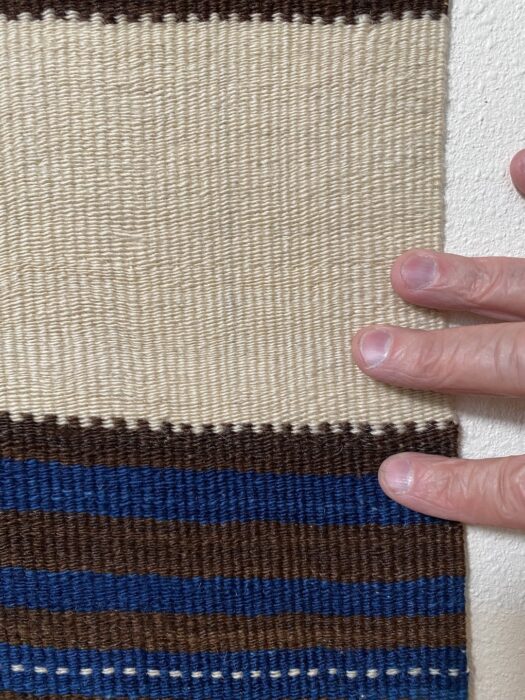
Tips For Collectors Of Navajo, Pueblo and Rio Grande Blankets
- by Jamie Compton
- in A closer look... Art Collecting My Thoughts on Native Art
- posted December 14, 2023
Tips For New Collectors
Collecting objects that you find beautiful, mysterious, or unusual is a great way to explore the human condition. The story can unfold from any perspective, but for me it’s all about blankets of the Southwest. Blankets, that give warmth, protection and an immediate sense of home, are the ideal expression for what it means to be human.
Weavings, especially Navajo, Pueblo and Rio Grande (Spanish Colonial) blankets, have held my keen interest for over 30 years. Fundamental to this is finding the earliest examples I can. The early era is about discovering the primal qualities of a culture, one that has not been so altered by Euro-American ways. The older the weaving is, the larger my world becomes. It’s as if I’m adding years to my life, being able to see the progression of how weaving changed as the world changed.
The earliest weavings have the most simple design and the most unadulterated ingredients. The wool, the dyes, the loom, the weaver – these all come together to create a story. It’s our investigative curiosity that helps us to picture what’s going on. The weaving is not only the matrix of warp and weft, it is also the essence of the weaver. This is an aspect perhaps seen, but more likely felt. I believe telepathy plays a primal role in how we viscerally see anything, and in this case, the weaver expressing itself through their work.
The earliest weavings came from the ancestral Pueblo people. Cotton and yucca fiber were the main ingredients since wool did not yet exist. It’s believed the Navajo came down from the North about 700-900 years ago and learned weaving from the Puebloans. It was not until the Spanish arrived in the 16th Century that wool became available, as well the design aesthetic brought over by these explorers. The height of Navajo weaving, called the classic period, lasted from about 1820 to 1865. By this period, outsiders had brought in new materials such as bayeta, or cloth, to be used in the blankets. The early Mexican saltillo with its fineness and complexity was a major contributor to the evolution of weaving in the Southwest. The saltillo was highly influential in the fast development of the Navajo classic era of weaving.
While there are amazing examples of blankets coming out of the classic period, most of these weavings, especially the serapes, are too busy for me. I would get tired looking at many of them, especially those with red as the dominant color and those with eye dazzling designs. I suspect that these complex patterns were more about pleasing the outsiders than the weavers themselves. These early examples remind me of the later Germantown era of Navajo weaving (1875 – 1900) where every color under the sun showed up and these machine plied yarns were so fine they helped the Navajo achieve looks similar to earlier saltillos. My preference is a first phase Ute blanket, an early design originating out of the Pueblos. When red bayeta is used, I prefer it to be used sparingly, like an accent rather than a dominant element. It’s the sublime I’m after. It is here I feel much stronger the presence of the weaver.
Critical steps in learning about what a blanket says.
There is nothing like seeing a weaving upfront and in person. While books and photographs are helpful, the true qualities can only be experienced in person. For that reason, I recommend seeing and touching as many weavings as you can.
-
Seek out museums with weaving displays
- Museum of Indian Arts & Culture current display: Horizons: Weaving Between the Lines with Diné Textiles
-
Follow searches on Ebay such as “Navajo rug” or “Navajo blanket”, “Pueblo blanket”, “Rio Grande blanket”
- Ebay search: Navajo Blanket
-
Use Liveauctioneers.com and Invaluable.com to search current and past sales for an approximate view of sold weavings along with value.
- Live Auctioneers search: Navajo blanket
- Invaluable auction search: Navajo blanket
-
Go to shows where weavings are shown and where you can meet other collectors.
The Vocabulary Of Navajo And Pueblo Weaving
Learn the vocabulary of Navajo and Pueblo weaving; warp, weft, sectional line, selvage, comb, batton, etc. If you can apply the words to a weaving in your hands, then you are much more likely to remember what they mean. These words will allow you to communicate ideas with others. The terms will also help you to recognize whether you have a Navajo, or a Pueblo or a Rio Grande weaving. Taking a weaving class, of any type, is extremely helpful in advancing this understanding.
Once you learn the terms, start to learn the different ways these terms can be used. There are sectional lines that belong to the earliest weavings which are different to the sectional lines in 20th and 21st century weavings. Learn what those differences are. There are selvages that are two ply and some three ply so what does this difference mean? There are selvages that are tight and only hold a few wefts, then there are selvages that span longer distances and hold many wefts. Why might this be the case? Do these small aspects tell us something more broadly about which group wove it? The answer is yes, and often more information is acquired from these points such as age, and perhaps even the region it was woven.
Nothing is more exciting than discovering an early blanket. For me, this means a 19th century blanket, and in my dreams, an 18th c. blanket. Because of my own quest, I have come to understand better over the years the qualities to look for in early weavings. Here are four points to look after.
Four Points On Discovering An Early Blanket
1. Take in the overall design
Does the design show evidence of early patterns? Banding is the earliest design motif used in weaving. Is the banding a simple series, or something more complex? Next, how does the blanket achieve designs outside of the simple band? Is there movement that goes on the diagonal, perhaps by taking small steps to make what is actually only horizontal and vertical, to appear at a 45 degree angle? The small steps used to create diagonal lines on weaving is a 19th century trait that gets lost by the 20th century. By the late 19th and early 20th centuries, the stepped diagonal disappears and becomes, instead, one weft stepping up at each warp. This creates a smooth diagonal line without steps.
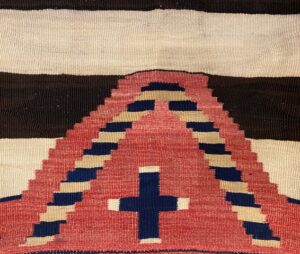
Navajo chief’s 3rd phase blanket circa 1865. The diagonal lines defining the red, and as well the alternating bars of indigo and yellow within the red, all show a stepped movement in creating the diagonal line. The red yarns are raveled Manchester bayeta dyed with cochineal.

Navajo transitional blanket circa 1890 showing, in red, a triangle shape where the diagonal line moves up one weft per one warp, making for a smooth line. This smooth, diagonal line is a later example of how weaving evolved away from the stepped pattern seen in the previous photo.
2. Determine The Type Of Wool/ Dyes Used
Once you have the design down, what type of wool is used and what type of dyes are used? Early wool is from churro sheep and here the fibers are long, parallel and not greasy. By the last quarter of the 19th Century we begin to see lower quality wool, or wool that is more fuzzy or woolen. Here the fibers are not parallel, they are kinky, and the wool often has more lanolin (grease) in it.
The following 3 photos show early blankets with characteristics of churro wool:
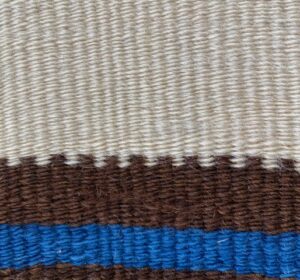
An early (circa 1850) Rio Grande blanket showing the high quality churro wool with long, parallel fibers.
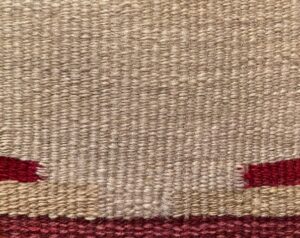
Navajo early child’s blanket or saddle blanket circa 1850 with high quality, churro wool. Even though the wefts are highly packed in, one can easily see the definition of the individual wefts, a character of churro wool with its long, parallel fibers. Note the raveled red and yellow yarns from bayeta at the bottom of the photo.

Navajo early child’s blanket or saddle blanket circa 1850 with high quality, churro wool. Even though the wefts are highly packed in, one can easily see the definition of the individual wefts, a character of churro wool with its long, parallel fibers.
The following 3 photos show Navajo weavings made after 1870 when other wool, such as rambouillet, became available and churro was much more rare:
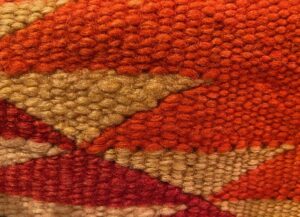
A Navajo transitional blanket circa 1890 showing synthetic dyes and later wool with lumpy and fuzzy characteristics and difficulty making yarn that is consistent in shape and size.
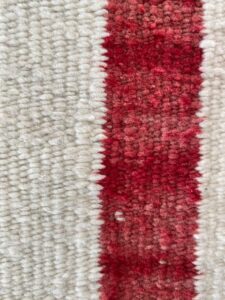
Navajo rug circa 1930 showing later wool and its fuzzy, lumpy nature. Notice how hard it is to make a consistent yarn size.
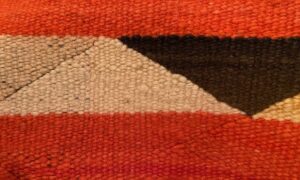
Transitional Navajo blanket, circa 1890 with synthetic dyes and wool that shows the fuzzy, lumpy nature of later (after 1870) wool.
Early blankets, much more than later blankets, use the natural wool available. White (actually a creamy butter white), brown and variations of grey are the most commonly used natural wool colors. Occasionally, the wool is dyed black or brown with local dyes such as pinon pitch. The most common natural dye added to the wool is indigo blue. This begins in the 17th Century and continues up till about 1880 when synthetic blue dyes take over. Red is the next most common color found. Before 1870, red will be either cochineal, lac, or a mixture of the two with both these dyes coming from small bugs found outside the Navajo Southwest.
These dyes are rare and valuable and were not available as a dye base for the weavers to work with. Instead, they had to buy or trade for wool cloth imported to the area from Europe, Mexico or the Eastern Seaboard. They would unravel the cloth to weave these fibers as wefts into the blanket. These cloths are called bayeta, a Spanish word for blanket or cloth. Other colors can be found as well with bayeta including but not limited to green, yellow, magenta and purple. It should be noted that cochineal dyed wool is a red that typically has a hint of blue, in contrast to synthetic red, which tends more towards orange. Once a blanket is found to have synthetic dyes in it, its age is considered to be after 1870. There are some tricks one can do to determine, approximately, if the dye used is natural or synthetic. But the only surefire way of knowing this is to get the wool professionally tested.
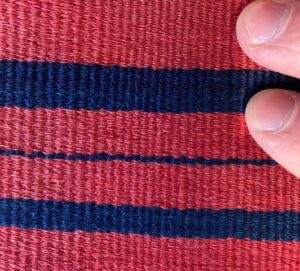
Navajo dress panel circa 1840 with red, raveled bayeta (very fine S spin, worsted wool) adjacent to hand spun wool dyed with indigo. The bayeta threads appear sharper and cleaner than the hand spun wool indigo yarn. This is part of the early look of raveled bayeta.
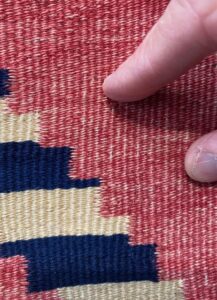
Navajo 3rd phase chief’s blanket with red (cochineal) coarsely raveled bayeta adjacent to yellow raveled bayeta and hand spun wool dyed with indigo. The red bayeta is likely Manchester bayeta, or cloth that was piece dyed with cochineal instead of yarn dyed. As a result, when the cloth is unraveled, the inner part of the cloth that did not receive the red dye shows up white. This creates the speckled look to the red areas.
3. Look At The Spin To the Wool Yarn
How the wool is spun is another important quality in considering age. Is the wool barely spun at all or is it tightly spun? It is easy to determine this by looking at the weft with a scope. Of course, one needs the experience of looking at multiple wool wefts to be able to determine what is lose and what is tight. The lighter the spin, the lighter the blanket. Like goose down, lightly spun wool is able to hold more air and is able to be warmer than tightly spun wool that is more a barrier than a warming element. Wool yarn that is tightly spun is heavier and may be used to hold back rain and snow. Not all tightly spun wool is later, but most lightly spun wool is earlier.

An early Navajo blanket circa 1865 showing the white wefts as barely having any spin to them. Notice how the fibers are relatively parallel to each other, defining how little spin there is. This makes the blanket lighter and warmer than a tightly spun wool yarn.
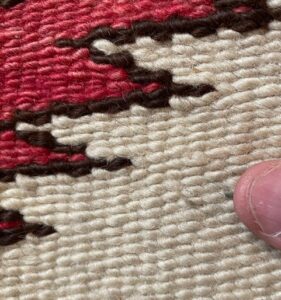
Navajo rug circa 1930 showing tightly spun yarn. One can see how twisted they are, giving some of the yarn a kink to it. This makes a heavier weaving typical for a rug.
4. How Does The Blanket “Feel”?
Lastly, and most elusive, how does this weaving feel? How it looks is objective, how it feels is subjective. What does it stir up? Is there an emotion relating to it? If so, are you happier, sadder, befuddled, rolled-over? Your primal reaction is important as this is the nonverbal communication created by the two of you having met. Being able to read this reaction may come easily to some and not at all to others.
A good way to experiment with this is to walk away from the blanket. Whether you go into the other room, or walk outside, what is leftover in its regard? Walk away long enough to forget about it, or at least to be drawn towards other things that help you to leave the blanket behind. Then, perhaps an hour later, or a day, go back and look at it. How does it feel to see it again? Do you see it differently? Do you like it more, or less? Review the sensations you had the last time compared to what is happening now. You can play this cycle over and over again.
I believe that objects created by human hands hold the energy of its maker. While most of the energy felt from a blanket is coming from you, some of it is coming from the blanket. There is a life and a story held in that blanket and you may well come privy to it. This mysterious experience is what makes life, and collecting, such a wonderful thing. The old adage the whole is greater than the sum of its parts is exactly what’s going on here. The evolution of the two identities meeting, you and the blanket, contributes to the advancement of our place in the world.
I have a healthy grouping of early Navajo, Pueblo and Rio Grande blankets that I would love to share with you as first hand examples of all that I write about. Please reach out when you are ready.

